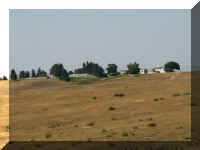 The
visitor center is near the Custer National Cemetery.
The
visitor center is near the Custer National Cemetery. Little Bighorn Battlefield National Monument - 2005
Updated: 11/09/08
Little Bighorn Battlefield National Monument memorializes one of the last armed efforts of the Northern Plains Indians to preserve their ancestral way of life. Here in the valley of the Little Bighorn River on two hot June days in 1876, more than 260 soldiers and attached personnel of the U. S. Army met defeat and death at the hands of several thousand Lakota and Cheyenne warriors. Among the dead were Lt. Col. George Armstrong Custer and every member of his immediate command.
 The
visitor center is near the Custer National Cemetery.
The
visitor center is near the Custer National Cemetery.
Last Stand Hill is a short walk from the visitor center.
Last Stand Hill has stone markers for Custer and many other Calvarymen.
Across the road from Custer Hill is the Indian Memorial Spirit Warriors. It represents all tribes who fought at Little Bighorn. Pictures and words along the inside walls share their histories. Inside the memorial, American Indians conduct tribal ceremonies.
The visitor center includes a collection of artifacts of the battle. Eric von Schmidt's painting "Here Fell Custer" is considered by Custer historians to be the most accurate portrayal on canvas of the battle and topography.
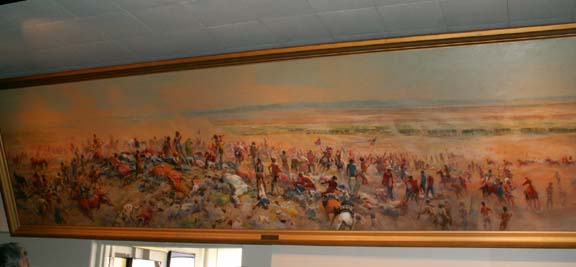
Gen. Custer's personal items were donated by his wife for display in a museum commemorating his life.
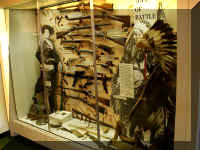 A
display named 'Tools of Battle' showed many weapons found in the battlefield
area. Some had very specific histories. Some were examples of weapons used. The
museum tags were carefully worded when the artifact's history could not be
confirmed.
A
display named 'Tools of Battle' showed many weapons found in the battlefield
area. Some had very specific histories. Some were examples of weapons used. The
museum tags were carefully worded when the artifact's history could not be
confirmed.
 This is what a 7th Calvaryman looked like in
uniform.
This is what a 7th Calvaryman looked like in
uniform. 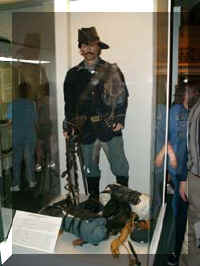
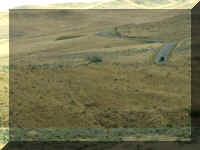 A
five-mile tour road traced the battlefield from Last Stand Hill to the Reno-Benteen
Battlefield. The road was very narrow, winding and hilly. The parking areas were
full. We were there in mid-September - we wondered how they handled peak traffic
demands.
A
five-mile tour road traced the battlefield from Last Stand Hill to the Reno-Benteen
Battlefield. The road was very narrow, winding and hilly. The parking areas were
full. We were there in mid-September - we wondered how they handled peak traffic
demands.
All along the tour road were stones marking where remains of Calvarymen were found. Some were identified, some were not.
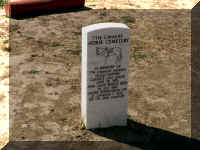 As you can imagine horses were very important to
Calvarymen. A horse cemetery was established to honor them.
As you can imagine horses were very important to
Calvarymen. A horse cemetery was established to honor them.
The monument at the Reno-Benteen Battlefield ...
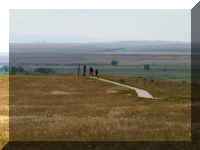 The
Little Bighorn Battlefield Monument was a very interesting. To obtain the sense
of the battlefield, you should drive the tour-road. Admission is $10 per private
vehicle if you don't have a discount pass. Allow at least 2 - 3 hours for the
visit - if you are a history buff allow more time. There are many sidewalks leading
into the battlefields for closer examination. It was hot and windy when we were
there. Comfortable shoes and a wind breaker are in order.
The
Little Bighorn Battlefield Monument was a very interesting. To obtain the sense
of the battlefield, you should drive the tour-road. Admission is $10 per private
vehicle if you don't have a discount pass. Allow at least 2 - 3 hours for the
visit - if you are a history buff allow more time. There are many sidewalks leading
into the battlefields for closer examination. It was hot and windy when we were
there. Comfortable shoes and a wind breaker are in order.
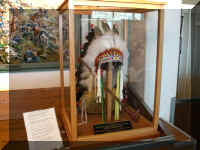 This
Peace Pipe and War Bonnet belonged to Hank Old Coyote. These are tokens very
important to the Crow Indians. Added to the display are personal tokens of the
life of PVT Lori Pietewa, of the Hopi Nation, who was the first woman killed in
battle on foreign soil - Iraq.
This
Peace Pipe and War Bonnet belonged to Hank Old Coyote. These are tokens very
important to the Crow Indians. Added to the display are personal tokens of the
life of PVT Lori Pietewa, of the Hopi Nation, who was the first woman killed in
battle on foreign soil - Iraq.